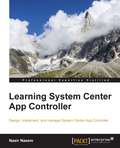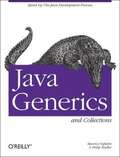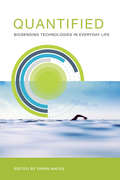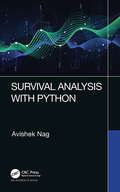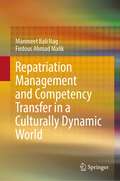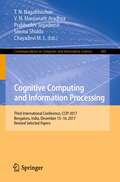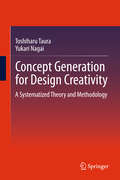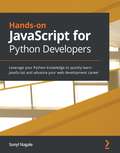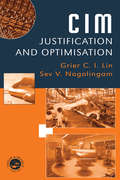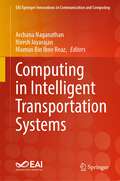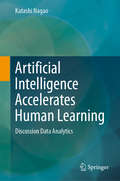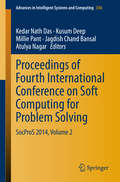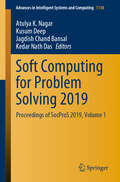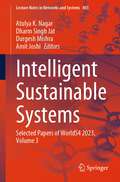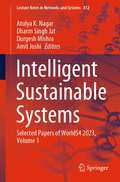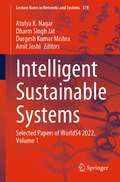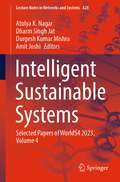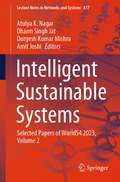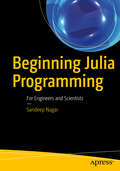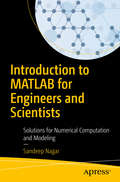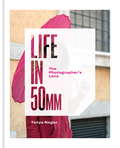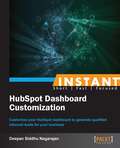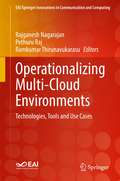- Table View
- List View
Learning System Center App Controller
by Nasir NaeemThis book is intended for IT professionals working with Hyper-V, Azure cloud, VMM, and private cloud technologies who are looking for a quick way to get up and running with System Center 2012 R2 App Controller. To get the most out of this book, you should be familiar with Microsoft Hyper-V technology. Knowledge of Virtual Machine Manager is helpful but not mandatory.
Java Generics and Collections
by Maurice Naftalin Philip WadlerThis comprehensive guide shows you how to master the most important changes to Java since it was first released. Generics and the greatly expanded collection libraries have tremendously increased the power of Java 5 and Java 6. But they have also confused many developers who haven't known how to take advantage of these new features. Java Generics and Collections covers everything from the most basic uses of generics to the strangest corner cases. It teaches you everything you need to know about the collections libraries, so you'll always know which collection is appropriate for any given task, and how to use it. Topics covered include: Fundamentals of generics: type parameters and generic methods Other new features: boxing and unboxing, foreach loops, varargs Subtyping and wildcards Evolution not revolution: generic libraries with legacy clients and generic clients with legacy libraries Generics and reflection Design patterns for generics Sets, Queues, Lists, Maps, and their implementations Concurrent programming and thread safety with collections Performance implications of different collections Generics and the new collection libraries they inspired take Java to a new level. If you want to take your software development practice to a new level, this book is essential reading. Philip Wadler is Professor of Theoretical Computer Science at the University of Edinburgh, where his research focuses on the design of programming languages. He is a co-designer of GJ, work that became the basis for generics in Sun's Java 5.0. Maurice Naftalin is Technical Director at Morningside Light Ltd., a software consultancy in the United Kingdom. He has most recently served as an architect and mentor at NSB Retail Systems plc, and as the leader of the client development team of a major UK government social service system. "A brilliant exposition of generics. By far the best book on the topic, it provides a crystal clear tutorial that starts with the basics and ends leaving the reader with a deep understanding of both the use and design of generics." Gilad Bracha, Java Generics Lead, Sun Microsystems
Quantified: Biosensing Technologies in Everyday Life
by Dawn NafusWhat is at stake socially, culturally, politically, and economically when we routinely use technology to gather information about our bodies and environments? Today anyone can purchase technology that can track, quantify, and measure the body and its environment. Wearable or portable sensors detect heart rates, glucose levels, steps taken, water quality, genomes, and microbiomes, and turn them into electronic data. Is this phenomenon empowering, or a new form of social control? Who volunteers to enumerate bodily experiences, and who is forced to do so? Who interprets the resulting data? How does all this affect the relationship between medical practice and self care, between scientific and lay knowledge? Quantified examines these and other issues that arise when biosensing technologies become part of everyday life.The book offers a range of perspectives, with views from the social sciences, cultural studies, journalism, industry, and the nonprofit world. The contributors consider data, personhood, and the urge to self-quantify; legal, commercial, and medical issues, including privacy, the outsourcing of medical advice, and self-tracking as a “paraclinical” practice; and technical concerns, including interoperability, sociotechnical calibration, alternative views of data, and new space for design.ContributorsMarc Böhlen, Geoffrey C. Bowker, Sophie Day, Anna de Paula Hanika, Deborah Estrin, Brittany Fiore-Gartland, Dana Greenfield, Judith Gregory, Mette Kragh-Furbo, Celia Lury, Adrian Mackenzie, Rajiv Mehta, Maggie Mort, Dawn Nafus, Gina Neff, Helen Nissenbaum, Heather Patterson, Celia Roberts, Jamie Sherman, Alex Taylor, Gary Wolf
Survival Analysis with Python
by Avishek NagSurvival analysis uses statistics to calculate time to failure. Survival Analysis with Python takes a fresh look at this complex subject by explaining how to use the Python programming language to perform this type of analysis. As the subject itself is very mathematical and full of expressions and formulations, the book provides detailed explanations and examines practical implications. The book begins with an overview of the concepts underpinning statistical survival analysis. It then delves into Parametric models with coverage of Concept of maximum likelihood estimate (MLE) of a probability distribution parameter MLE of the survival function Common probability distributions and their analysis Analysis of exponential distribution as a survival function Analysis of Weibull distribution as a survival function Derivation of Gumbel distribution as a survival function from Weibull Non-parametric models including Kaplan–Meier (KM) estimator, a derivation of expression using MLE Fitting KM estimator with an example dataset, Python code and plotting curves Greenwood’s formula and its derivation Models with covariates explaining The concept of time shift and the accelerated failure time (AFT) model Weibull-AFT model and derivation of parameters by MLE Proportional Hazard (PH) model Cox-PH model and Breslow’s method Significance of covariates Selection of covariates The Python lifelines library is used for coding examples. By mapping theory to practical examples featuring datasets, this book is a hands-on tutorial as well as a handy reference.
Repatriation Management and Competency Transfer in a Culturally Dynamic World
by Manmeet Bali Nag Firdous Ahmad MalikThis book examines the relevance of global strategic perspective, as international competition continues to intensify & gain momentum, and management of human resource remains a challenge in contemporary corporate scenario. As global business strategy requires globally competent people and implementation of global human resource systems, therefore the need to harness the multi-faceted dimensions of corporate employees is elaborated upon. This book explores cross cultural movement & interactions in International human resource management, where the theme of cross-cultural reentry remains largely neglected and underestimated in the sojourner’s transition trajectory. This book takes into account the available empirical investigations pointing to substantial concerns, affecting the psychological wellbeing, social readjustment and cultural identity of the returning individuals. This book examines the significance of re-entry as an issue of highest priority to both sojourning individuals as well as people managing the reentry transitions of travelers. In light of the unfolding knowledge revolution, the book explores the context of corporate India offering high knowledge density and rich demographic dividend. The need for companies, to harness the knowledge capital and accelerate Indians in the knowledge revolution is examined. Various factors that can influence the repatriation of an individual when back in the home country, and the challenges faced in repatriation at the individual-, team-, organizational-, and country-levels, is explored & analyzed. This book focuses on eliminating overall wastage and losses in Repatriation process, from an organizational point of view.The purview of this book encompasses the interface of Anticipatory Adjustment, Competency Transfer, Effective Repatriation and Reverse Culture Shock with Repatriates’ Adjustment, back home, and empirically analyzes the precursors and effects of the said paradigms in optimization of Repatriate talent from an organizational perspective. The purpose is to analyze the antecedents of repatriate adjustment in the mentioned context and to subsequently deliberate upon the acquired results to arrive at feasible and relevant conclusions. Optimization of Repatriate talent, and Repatriation Management from International Human Resource Management (IHRM) perspective, deserves a cross-disciplinary study of precursors effecting Repatriation Adjustment, with focus on the dimension of Indian Repatriate acculturation.
Cognitive Computing and Information Processing: Third International Conference, Ccip 2017, Bengaluru, India, December 15-16, 2017, Revised Selected Papers (Communications In Computer And Information Science #801)
by T. N. Nagabhushan V. N. Manjunath Aradhya Prabhudev Jagadeesh Seema Shukla Chayadevi M. L.This book constitutes the refereed proceedings of the Third International Conference on Cognitive Computing and Information Processing, CCIP 2017, held in Bengaluru, India, in December 2017. The 43 revised full papers presented were carefully reviewed and selected from 130 submissions. The papers are organized in topical sections on cognitive computing in medical information processing; cognitive computing and its applications; cognitive computing in video analytics.
Concept Generation for Design Creativity: A Systematized Theory and Methodology
by Yukari Nagai Toshiharu TauraThe concept generation process seems like an intuitional thought: difficult to capture and perform, although everyone is capable of it. It is not an analytical process but a synthetic process which has yet to be clarified. Furthermore, new research methods for investigating the concept generation process--a very difficult task since the concept generation process is driven by inner feelings deeply etched in the mind--are necessary to establish its theory and methodology. Concept Generation for Design Creativity - A Systematized Theory and Methodology presents the concept generation process both theoretically and methodologically. Theoretically, the concept generation process is discussed by comparing metaphor, abduction, and General Design Theory from the notions of similarities and dissimilarities. Analogy, blending, and integration by thematic relation have been explained methodologically. So far, these theories and methods have been discussed independently, and the relations among them have not been clarified. Two newly developed research methods to investigate the concept generation process are clearly explained: the explanation-based protocol analysis and constructive simulation. By reading Concept Generation for Design Creativity - A Systematized Theory and Methodology, students, researchers and lecturers in design disciplines (including engineering design, industrial design, software design, CHI, design education, and cognitive science ) can obtain a clear picture of the advanced research findings and the outline of the theories and methods for concept generation. Furthermore, readers are expected to achieve the competence to generate new concepts.
Hands-on JavaScript for Python Developers: Leverage your Python knowledge to quickly learn JavaScript and advance your web development career
by Sonyl NagaleBuild robust full-stack web applications using two of the world's most popular programming languages Python and JavaScript Key Features Discover similarities and differences between JavaScript and Python coding conventions Explore frontend web concepts, UI/UX techniques, and JavaScript frameworks to enhance your web development skills Put your JS knowledge into practice by developing a full-stack web app with React and Express Book Description Knowledge of Python is a great foundation for learning other languages. This book will help you advance in your software engineering career by leveraging your Python programming skills to learn JavaScript and apply its unique features not only for frontend web development but also for streamlining work on the backend. Starting with the basics of JavaScript, you'll cover its syntax, its use in the browser, and its frameworks and libraries. From working with user interactions and ingesting data from APIs through to creating APIs with Node.js, this book will help you get up and running with JavaScript using hands-on exercises, code snippets, and detailed descriptions of JavaScript implementation and benefits. To understand the use of JavaScript in the backend, you'll explore Node.js and discover how it communicates with databases. As you advance, you'll get to grips with creating your own RESTful APIs and connecting the frontend and backend for holistic full-stack development knowledge. By the end of this Python JavaScript book, you'll have the knowledge you need to write full-fledged web applications from start to finish. You'll have also gained hands-on experience of working through several projects, which will help you advance in your career as a JavaScript developer. What you will learn Discover the differences between Python and JavaScript at both the syntactical and semantical level Become well versed in implementing JavaScript in the frontend as well as the backend Understand the separation of concerns while using Python programming for server-side development Get to grips with frontend web development tasks, including UI/UX design, form validation, animations, and much more Create modern interaction interfaces for your Python web application Explore modern web technologies and libraries for building full-stack applications Who this book is for This book is for experienced Python programmers who are looking to expand their knowledge of frontend and backend web development with JavaScript. An understanding of data types, functions, and scope is necessary to get to grips with the concepts covered in the book. Familiarity with HTML and CSS, Document Object Model (DOM), and Flask or Django will help you to learn JavaScript easily.
CIM Justification and Optimisation
by Sev V NagalingamThis book provides a justification and optimisation model that is complete enough to capture the important features required for a complex decision-making environment for computer integrated manufacturing investment analysis. The model provides facilities to quantify qualitative attributes.
Computing in Intelligent Transportation Systems (EAI/Springer Innovations in Communication and Computing)
by Archana Naganathan Niresh Jayarajan Mamun Bin Ibne ReazThis book presents various application areas of computing in the automotive sector. The authors explain how computing enhances the performance of vehicles, covering the applications of computing in smart transportation and the future scope. The authors focus on computing for vehicle safety in conjunction with the latest technologies in Internet of Things (IoT). The book provides a holistic approach to computing in an inter-disciplinary and unified view. Topics covered include driverless automated navigation systems, smart transportation, self-learning systems, in-vehicle intelligent systems, and off-road vehicle diagnosis and maintenance, among others. The authors include simulated examples and case studies for better understanding of the technologies and applications. The book is intended for a wide range of readers from students to researchers and industry practitioners and is a useful resource for those planning to pursue research in the area of computing and autonomous driving vehicles.
Artificial Intelligence Accelerates Human Learning: Discussion Data Analytics
by Katashi NagaoFocusing on students’ presentations and discussions in laboratory seminars, this book presents case studies on evidence-based education using artificial intelligence (AI) technologies. It proposes a system to help users complete research activities, and a machine-learning method that makes the system suitable for long-term operation by performing data mining for discussions and automatically extracting essential tasks. By illustrating the complete process – proposal, implementation, and operation – of applying machine learning techniques to real-world situations, the book will inspire researchers and professionals to develop innovative new applications for education. The book is divided into six chapters, the first of which provides an overview of AI research and practice in education. In turn, Chapter 2 describes a mechanism for applying data analytics to student discussions and utilizing the results for knowledge creation activities such as research. Based on discussion data analytics, Chapter 3 describes a creative activity support system that effectively utilizes the analytical results of the discussion for subsequent activities. Chapter 4 discusses the incorporation of a gamification method to evaluate and improve discussion skills while maintaining the motivation to participate in the discussion. Chapters 5 and 6 describe an advanced learning environment for honing students’ discussion and presentation skills. Two important systems proposed here are a presentation training system using virtual reality technologies, and an interactive presentation/discussion training system using a humanoid robot. In the former, the virtual space is constructed by measuring the three-dimensional shape of the actual auditorium, presentations are performed in the same way as in the real world, and the AI as audience automatically evaluates the presentation and provides feedback. In the latter, a humanoid robot makes some remarks on and asks questions about students’ presentations, and the students practice responding to it.
Proceedings of Fourth International Conference on Soft Computing for Problem Solving
by Atulya Nagar Jagdish Chand Bansal Millie Pant Kusum Deep Kedar Nath DasThe Proceedings of SocProS 2014 serves as an academic bonanza for scientists and researchers working in the field of Soft Computing. This book contains theoretical as well as practical aspects using fuzzy logic, neural networks, evolutionary algorithms, swarm intelligence algorithms, etc. , with many applications under the umbrella of 'Soft Computing'. The book is beneficial for young as well as experienced researchers dealing across complex and intricate real world problems for which finding a solution by traditional methods is a difficult task. The different application areas covered in the Proceedings are: Image Processing, Cryptanalysis, Industrial Optimization, Supply Chain Management, Newly Proposed Nature Inspired Algorithms, Signal Processing, Problems related to Medical and Healthcare, Networking Optimization Problems, etc.
Soft Computing for Problem Solving 2019: Proceedings of SocProS 2019, Volume 1 (Advances in Intelligent Systems and Computing #1138)
by Atulya K. Nagar Kusum Deep Jagdish Chand Bansal Kedar Nath DasThis book features the outcomes of the 9th International Conference on Soft Computing for Problem Solving, SocProS 2019, which brought together researchers, engineers and practitioners to discuss thought-provoking developments and challenges in order to identify potential future directions. The book presents the latest advances and innovations in the interdisciplinary areas of soft computing, including original research papers in areas such as algorithms (artificial immune systems, artificial neural networks, genetic algorithms, genetic programming, and particle swarm optimization) and applications (control systems, data mining and clustering, finance, weather forecasting, game theory, business and forecasting applications). It is a valuable resource for both young and experienced researchers dealing with complex and intricate real-world problems that cannot easily be solved using traditional methods.
Intelligent Sustainable Systems: Selected Papers of WorldS4 2023, Volume 3 (Lecture Notes in Networks and Systems #803)
by Atulya K. Nagar Dharm Singh Jat Durgesh Mishra Amit JoshiThis book provides insights of World Conference on Smart Trends in Systems, Security, and Sustainability (WS4 2023) which is divided into different sections such as Smart IT Infrastructure for Sustainable Society; Smart Management Prospective for Sustainable Society; Smart Secure Systems for Next Generation Technologies; Smart Trends for Computational Graphics and Image Modeling; and Smart Trends for Biomedical and Health Informatics. The proceedings is presented in two volumes. The book is helpful for active researchers and practitioners in the field.
Intelligent Sustainable Systems: Selected Papers of WorldS4 2023, Volume 1 (Lecture Notes in Networks and Systems #812)
by Atulya K. Nagar Dharm Singh Jat Durgesh Mishra Amit JoshiThis book provides insights of World Conference on Smart Trends in Systems, Security and Sustainability (WS4 2023) which is divided into different sections such as Smart IT Infrastructure for Sustainable Society; Smart Management Prospective for Sustainable Society; Smart Secure Systems for Next Generation Technologies; Smart Trends for Computational Graphics and Image Modeling; and Smart Trends for Biomedical and Health Informatics. The proceedings is presented in four volumes. The book is helpful for active researchers and practitioners in the field.
Intelligent Sustainable Systems: Selected Papers of WorldS4 2022, Volume 1 (Lecture Notes in Networks and Systems #578)
by Atulya K. Nagar Dharm Singh Jat Durgesh Kumar Mishra Amit JoshiThis book provides insights of World Conference on Smart Trends in Systems, Security and Sustainability (WS4 2022) which is divided into different sections such as Smart IT Infrastructure for Sustainable Society; Smart Management Prospective for Sustainable Society; Smart Secure Systems for Next Generation Technologies; Smart Trends for Computational Graphics and Image Modeling; and Smart Trends for Biomedical and Health Informatics. The proceedings is presented in two volumes. The book is helpful for active researchers and practitioners in the field.
Intelligent Sustainable Systems: Selected Papers of WorldS4 2023, Volume 4 (Lecture Notes in Networks and Systems #828)
by Atulya K. Nagar Dharm Singh Jat Durgesh Kumar Mishra Amit JoshiThis book provides insights of World Conference on Smart Trends in Systems, Security and Sustainability (WS4 2023) which is divided into different sections such as Smart IT Infrastructure for Sustainable Society; Smart Management Prospective for Sustainable Society; Smart Secure Systems for Next Generation Technologies; Smart Trends for Computational Graphics and Image Modeling; and Smart Trends for Biomedical and Health Informatics. The proceedings is presented in four volumes. The book is helpful for active researchers and practitioners in the field.
Intelligent Sustainable Systems: Selected Papers of WorldS4 2023, Volume 2 (Lecture Notes in Networks and Systems #817)
by Atulya K. Nagar Dharm Singh Jat Durgesh Kumar Mishra Amit JoshiThis book provides insights of World Conference on Smart Trends in Systems, Security and Sustainability (WS4 2023) which is divided into different sections such as Smart IT Infrastructure for Sustainable Society; Smart Management Prospective for Sustainable Society; Smart Secure Systems for Next Generation Technologies; Smart Trends for Computational Graphics and Image Modeling; and Smart Trends for Biomedical and Health Informatics. The proceedings is presented in two volumes. The book is helpful for active researchers and practitioners in the field.
Beginning Julia Programming: For Engineers and Scientists
by Sandeep NagarGet started with Julia for engineering and numerical computing, especially data science, machine learning, and scientific computing applications. This book explains how Julia provides the functionality, ease-of-use and intuitive syntax of R, Python, MATLAB, SAS, or Stata combined with the speed, capacity, and performance of C, C++, or Java. You'll learn the OOP principles required to get you started, then how to do basic mathematics with Julia. Other core functionality of Julia that you'll cover, includes working with complex numbers, rational and irrational numbers, rings, and fields. Beginning Julia Programming takes you beyond these basics to harness Julia's powerful features for mathematical functions in Julia, arrays for matrix operations, plotting, and more. Along the way, you also learn how to manage strings, write functions, work with control flows, and carry out I/O to implement and leverage the mathematics needed for your data science and analysis projects. "Julia walks like Python and runs like C". This phrase explains why Julia is quickly growing as the most favored option for data analytics and numerical computation. After reading and using this book, you'll have the essential knowledge and skills to build your first Julia-based application. What You'll Learn Obtain core skills in Julia Apply Julia in engineering and science applications Work with mathematical functions in Julia Use arrays, strings, functions, control flow, and I/O in Julia Carry out plotting and display basic graphics Who This Book Is For Those who are new to Julia; experienced users may also find this helpful as a reference.
Introduction to MATLAB for Engineers and Scientists
by Sandeep NagarFamiliarize yourself with MATLAB using this concise, practical tutorial that is focused on writing code to learn concepts. Starting from the basics, this book covers array-based computing, plotting and working with files, numerical computation formalism, and the primary concepts of approximations. Introduction to MATLAB is useful for industry engineers, researchers, and students who are looking for open-source solutions for numerical computation. In this book you will learn by doing, avoiding technical jargon, which makes the concepts easy to learn. First you'll see how to run basic calculations, absorbing technical complexities incrementally as you progress toward advanced topics. Throughout, the language is kept simple to ensure that readers at all levels can grasp the concepts. What You'll Learn Apply sample code to your engineering or science problems Work with MATLAB arrays, functions, and loops Use MATLAB's plotting functions for data visualization Solve numerical computing and computational engineering problems with a MATLAB case study Who This Book Is For Engineers, scientists, researchers, and students who are new to MATLAB. Some prior programming experience would be helpful but not required.
Life in 50mm: The Photographer's Lens
by Tanya NagarThe 50mm lens is for photography purists. It's cheap to buy, light to carry and gets amazing results. It also makes even the greatest photographers try just that little bit harder to frame the perfect image. As a result, it's the first thing anyone buys after their camera. Life in 50mm shares the greatest photos - and the personal experiences that led to them - from some of today's leading photographers. It also explains why they chose to reject complicated modern zooms and express themselves through the 50mm prime in the first place.
Life in 50mm: The Photographer's Lens
by Tanya NagarThe 50mm lens is for photography purists. It's cheap to buy, light to carry and gets amazing results. It also makes even the greatest photographers try just that little bit harder to frame the perfect image. As a result, it's the first thing anyone buys after their camera. Life in 50mm shares the greatest photos - and the personal experiences that led to them - from some of today's leading photographers. It also explains why they chose to reject complicated modern zooms and express themselves through the 50mm prime in the first place.
The New Street Photographers Manifesto: Any Camera, Anywhere
by Tanya NagarWhether you shoot with a digital SLR, a Holga or the camera on your phone, today's cameras let you seize the moment and shoot whenever and wherever you like. This makes them perfect for street photography, the genre of choice of some of the greatest photographers of all time, with names like Henri Cartier-Bresson, Weegee and Robert Frank turning gritty reality into iconic images.In this book, Tanya Nagar will open your eyes to the photographic potential of your urban world environment, offering the tricks and techniques that put you in the right place, at the right time, and let you create amazing photos. In addition to everything that'll give you the right skills and headspace to capture great images on the street, Nagar has brought together a stunning showcase of some of the greatest emerging street photographers of our age to inspire you.
Instant HubSpot Dashboard Customization
by Deepan Siddhu NagarajanFilled with practical, step-by-step instructions and clear explanations for the most important and useful tasks. A headlong guide including example driving situations, clear instructions for important tasks, and details for enhancing your social media management experience. This book is a perfect fit if you are an inbound marketing beginner who feels and believes that handling multiple marketing channels to generate leads is a cumbersome activity. The best part is, you don't need to have coding skills to customize your Hubspot portal when you've got this book. Basic knowledge of computers is essential.
Operationalizing Multi-Cloud Environments: Technologies, Tools and Use Cases (EAI/Springer Innovations in Communication and Computing)
by Rajganesh Nagarajan Pethuru Raj Ramkumar ThirunavukarasuThis book discusses various aspects of the multi-cloud paradigm. The initial portion of the book focuses on the motivations for the industry to embrace a multi-cloud option and the distinct business, technology, and user cases of multi-cloud implementations. The middle part of the book explains the challenges of setting up and sustaining multi-cloud environments. The latter portion focuses on the next-generation technologies and tools along with multi-cloud platforms, processes, patterns, and practices. The final segment of the book is dedicated for cloud brokerage systems. The various traits and tenets of cloud brokerage services especially for accomplishing cloud intermediation, integration, orchestration, governance, security, management, configuration, etc. are explained in detail. The book also clearly articulates how to have intelligent brokers.
